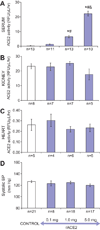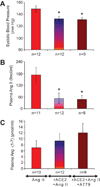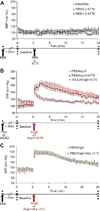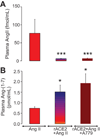Targeting the degradation of angiotensin II with recombinant angiotensin-converting enzyme 2: prevention of angiotensin II-dependent hypertension
- PMID: 19948988
- PMCID: PMC2827767
- DOI: 10.1161/HYPERTENSIONAHA.109.138420
Targeting the degradation of angiotensin II with recombinant angiotensin-converting enzyme 2: prevention of angiotensin II-dependent hypertension
Abstract
Angiotensin (Ang)-converting enzyme 2 (ACE2) cleaves Ang II to form Ang-(1-7). Here we examined whether soluble human recombinant ACE2 (rACE2) can efficiently lower Ang II and increase Ang-(1-7) and whether rACE2 can prevent hypertension caused by Ang II infusion as a result of systemic versus local mechanisms of ACE2 activity amplification. rACE2 was infused via osmotic minipumps for 3 days in conscious mice or acutely in anesthetized mice. rACE2 caused a dose-dependent increase in serum ACE2 activity but had no effect on kidney or cardiac ACE2 activity. After Ang II infusion (40 pmol/min), rACE2 (1 mg/kg per day) resulted in normalization of systolic blood pressure and plasma Ang II. In acute studies, rACE2 (1 mg/kg) prevented the rapid hypertensive effect of Ang II (0.2 mg/kg), and this was associated with both a decrease in Ang II and an increase in Ang-(1-7) in plasma. Moreover, during infusion of Ang II, the effect of rACE2 on blood pressure was unaffected by a specific Ang-(1-7) receptor blocker, A779 (0.2 mg/kg), and infusing supraphysiologic levels of Ang-(1-7) (0.2 mg/kg) had no effect on blood pressure. We conclude that, during Ang II infusion, rACE2 effectively degrades Ang II and, in the process, normalizes blood pressure. The mechanism of rACE2 action results from an increase in systemic, not tissue, ACE2 activity and the lowering of plasma Ang II rather than the attendant increase in Ang-(1-7). Increasing ACE2 activity may provide a new therapeutic target in states of Ang II overactivity by enhancing its degradation, an approach that differs from the current focus on blocking Ang II formation and action.
Figures






Similar articles
-
Angiotensin-converting enzyme 2-independent action of presumed angiotensin-converting enzyme 2 activators: studies in vivo, ex vivo, and in vitro.Hypertension. 2014 Apr;63(4):774-82. doi: 10.1161/HYPERTENSIONAHA.113.02856. Epub 2014 Jan 20. Hypertension. 2014. PMID: 24446061 Free PMC article.
-
Murine recombinant angiotensin-converting enzyme 2: effect on angiotensin II-dependent hypertension and distinctive angiotensin-converting enzyme 2 inhibitor characteristics on rodent and human angiotensin-converting enzyme 2.Hypertension. 2012 Sep;60(3):730-40. doi: 10.1161/HYPERTENSIONAHA.112.198622. Epub 2012 Jul 9. Hypertension. 2012. PMID: 22777933 Free PMC article.
-
New mass spectrometric assay for angiotensin-converting enzyme 2 activity.Hypertension. 2006 May;47(5):1010-7. doi: 10.1161/01.HYP.0000215588.38536.30. Epub 2006 Apr 3. Hypertension. 2006. PMID: 16585421
-
Angiotensin-converting enzyme 2: enhancing the degradation of angiotensin II as a potential therapy for diabetic nephropathy.Kidney Int. 2012 Mar;81(6):520-8. doi: 10.1038/ki.2011.381. Epub 2011 Nov 23. Kidney Int. 2012. PMID: 22113528 Review.
-
ACE2 and vasoactive peptides: novel players in cardiovascular/renal remodeling and hypertension.Ther Adv Cardiovasc Dis. 2015 Aug;9(4):217-37. doi: 10.1177/1753944715597623. Epub 2015 Aug 13. Ther Adv Cardiovasc Dis. 2015. PMID: 26275770 Review.
Cited by
-
Increased urinary angiotensin-converting enzyme 2 in renal transplant patients with diabetes.PLoS One. 2012;7(5):e37649. doi: 10.1371/journal.pone.0037649. Epub 2012 May 22. PLoS One. 2012. PMID: 22629438 Free PMC article.
-
The prognostic importance of the angiotensin II/angiotensin-(1-7) ratio in patients with SARS-CoV-2 infection.Ther Adv Respir Dis. 2022 Jan-Dec;16:17534666221122544. doi: 10.1177/17534666221122544. Ther Adv Respir Dis. 2022. PMID: 36082632 Free PMC article.
-
Effect of etelcalcetide on cardiac hypertrophy in hemodialysis patients: a randomized controlled trial (ETECAR-HD).Trials. 2019 Oct 24;20(1):601. doi: 10.1186/s13063-019-3707-7. Trials. 2019. PMID: 31651370 Free PMC article.
-
Regulation of Angiotensin-Converting Enzyme 2: A Potential Target to Prevent COVID-19?Front Endocrinol (Lausanne). 2021 Oct 22;12:725967. doi: 10.3389/fendo.2021.725967. eCollection 2021. Front Endocrinol (Lausanne). 2021. PMID: 34745001 Free PMC article. Review.
-
Recombinant human angiotensin-converting enzyme 2 as a new renin-angiotensin system peptidase for heart failure therapy.Curr Heart Fail Rep. 2011 Sep;8(3):176-83. doi: 10.1007/s11897-011-0063-7. Curr Heart Fail Rep. 2011. PMID: 21611889 Review.
References
-
- Donoghue M, Hsieh F, Baronas E, Godbout K, Gosselin M, Stagliano N, Donovan M, Woolf B, Robison K, Jeyaseelan R, Breibart RE, Acton S. A novel angiotensin-coverting enzyme-related carboxypeptidase (ACE2) converts antiogensin I to angiotensin 1-9. Circ Res. 2000;87:E1–E9. - PubMed
-
- Tipnis SR, Hooper NM, Hyde R, Karran E, Christie G, Turner AJ. A human homolog of angiotensin-converting enzyme. Cloning and functional expression as a captopril-insensitive carboxypeptidase. J Biol Chem. 2000;274:33238–33243. - PubMed
-
- Vickers C, Hales P, Kaushik V, Dick L, Gavin J, Tang J, Godbout K, Parsons T, Baronas E, Hsieh F, Acton S, Patane M, Nichols A, Tummino P. Hydrolysis of biological peptides by human angiotensin-converting enzyme-related carboxypeptidase. J Biol Chem. 2002;277:14838–14843. - PubMed
-
- Ye M, Wysocki J, Naaz P, Salabat R, LaPointe MS, Batlle D. Increased ACE2 and decreased ACE protein in renal tubules from diabetic mice: A renoprotective combination? Hypertension. 2004;43:1120–1125. - PubMed
-
- Ye M, Wysocki J, William J, Soler MJ, Cokic I, Batlle D. Glomerular localization and expression of angiotensin-converting enzyme 2 and angiotensin-converting enzyme: implications for albuminuria in diabetes. J Am Soc Nephrol. 2006;17:3067–3075. - PubMed
Publication types
MeSH terms
Substances
Grants and funding
LinkOut - more resources
Full Text Sources
Other Literature Sources
Medical
Molecular Biology Databases
Miscellaneous

